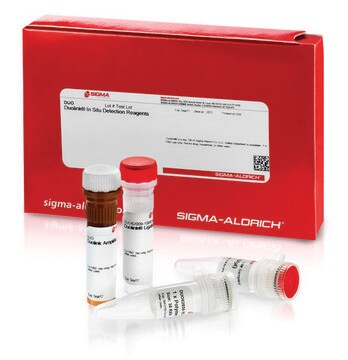DUO82049
Duolink® In Situ Wash Buffers, Fluorescence
Synonym(s):
in situ Proximity Ligation Assay reagent, Protein Protein Interaction Assay reagent
Sign Into View Organizational & Contract Pricing
All Photos(1)
About This Item
UNSPSC Code:
12161703
NACRES:
NA.32
Recommended Products
material
packing (powdered buffer pouches)
Quality Level
product line
Duolink®
technique(s)
proximity ligation assay: suitable
suitability
suitable for fluorescence
storage temp.
20-25°C
Related Categories
Application
Duolink®proximity ligation assay(PLA®) allows for endogenous detection of protein interactions, post translational modifications, and protein expression levels at the single molecule level in fixed cells and tissue samples.
Use the Duolink® In Situ Fluorescence Protocol for this product. A set of short instructionsis also available.
Visit our Duolink® PLA Resource Center for information on how to run a Duolink® experiment, applications, troubleshooting, and more.
To perform a complete Duolink® PLA in situ experiment you will need two primary antibodies (PLA, IHC, ICC or IF validated) that recognize two target epitopes. Other necessary reagents include a pair of PLA probes from different species (one PLUS and one MINUS), detection reagents, wash buffers, and mounting medium. Note that the primary antibodies must come from the same species as the Duolink® PLA probes. Analysis is carried out using standard immunofluorescence assay equipment.
Use the Duolink® In Situ Fluorescence Protocol for this product. A set of short instructionsis also available.
Visit our Duolink® PLA Resource Center for information on how to run a Duolink® experiment, applications, troubleshooting, and more.
To perform a complete Duolink® PLA in situ experiment you will need two primary antibodies (PLA, IHC, ICC or IF validated) that recognize two target epitopes. Other necessary reagents include a pair of PLA probes from different species (one PLUS and one MINUS), detection reagents, wash buffers, and mounting medium. Note that the primary antibodies must come from the same species as the Duolink® PLA probes. Analysis is carried out using standard immunofluorescence assay equipment.
Specificity
Duolink® In Situ fluorescence applications use two wash buffers. Wash Buffer A is used after the PLA Probe incubation step and Wash Buffer B is used after incubation with the amplification reagents. See datasheet for more information.
Application Note
Two primary antibodies raised in different species are needed. Test your primary antibodies (IgG-class, mono- or polyclonal) in a standard immunofluorescence (IF), immunohistochemistry (IHC) or immunocytochemistry (ICC) assay to determine the optimal fixation, blocking, and titer conditions. Duolink®PLA in situ reagents are suitable for use on fixed cells, cytospin cells, cells grown on slide, formalin-fixed, paraffin embedded (FFPE), or tissue (fresh or frozen). No minimum number of cells is required.
Linkage
Let us do the work for you, learn more about our Custom Service Program to accelerate your Duolink® projects
View full Duolink® product list
Duolink® In Situ fluorescence applications use two wash buffers. Wash Buffer A is used after the PLA Probe incubation step and Wash Buffer B is used after incubation with the amplification reagents. See datasheet for more information.
Application Note
Two primary antibodies raised in different species are needed. Test your primary antibodies (IgG-class, mono- or polyclonal) in a standard immunofluorescence (IF), immunohistochemistry (IHC) or immunocytochemistry (ICC) assay to determine the optimal fixation, blocking, and titer conditions. Duolink®PLA in situ reagents are suitable for use on fixed cells, cytospin cells, cells grown on slide, formalin-fixed, paraffin embedded (FFPE), or tissue (fresh or frozen). No minimum number of cells is required.
Linkage
Let us do the work for you, learn more about our Custom Service Program to accelerate your Duolink® projects
View full Duolink® product list
Duolink® PLA in situ reagents are suitable for use on fixed cells, cytospin cells, cells grown on slide, formalin-fixed, paraffin embedded (FFPE), or tissue (fresh or frozen).
Features and Benefits
- No overexpression or genetic manipulation required
- High specificity (fewer false positives)
- Single molecule sensitivity due to rolling circle amplification
- Relative quantification possible
- No special equipment needed
- Quicker and simpler than FRET
- Increased accuracy compared to co-IP
- Publication-ready results
Legal Information
Duolink is a registered trademark of Merck KGaA, Darmstadt, Germany
PLA is a registered trademark of Merck KGaA, Darmstadt, Germany
Storage Class Code
10 - Combustible liquids
WGK
WGK 3
Choose from one of the most recent versions:
Already Own This Product?
Find documentation for the products that you have recently purchased in the Document Library.
Customers Also Viewed
Increasing the Receptor Tyrosine Kinase EphB2 Prevents Amyloid-?-induced Depletion of Cell Surface Glutamate Receptors by a Mechanism That Requires the PDZ-binding Motif of EphB2 and Neuronal Activity
Miyamoto T, et al.
The Journal of Biological Chemistry (2015)
Detection of Receptor Heteromerization Using In Situ Proximity Ligation Assay
Gomes I, et al.
Current Protocols in Pharmacology / Editorial Board, S.J. Enna (editor-in-chief) ... [Et al.], 2-16 (2016)
Proximal Ligation Assay (PLA) on Lung Tissue and Cultured Macrophages to Demonstrate Protein-protein Interaction
Mendez R, et al.
Bio-protocol, 7(21) (2017)
Xiaofan Li et al.
Journal of virology, 93(17) (2019-06-14)
Herpesviruses are ubiquitous, and infection by some, like Epstein-Barr virus (EBV), is nearly universal. To persist, EBV must periodically switch from a latent to a replicative/lytic phase. This productive phase is responsible for most herpesvirus-associated diseases. EBV encodes a latency-to-lytic
Xiaofan Li et al.
PLoS pathogens, 13(3), e1006249-e1006249 (2017-03-02)
Trials to reintroduce chloroquine into regions of Africa where P. falciparum has regained susceptibility to chloroquine are underway. However, there are long-standing concerns about whether chloroquine increases lytic-replication of Epstein-Barr virus (EBV), thereby contributing to the development of endemic Burkitt
Articles
Find Duolink references based on the type of method used, post translational modification detected, and research focus.
Protocols
Duolink® PLA Multicolor Detection Protocol
Global Trade Item Number
| SKU | GTIN |
|---|---|
| DUO82049-20L | 4061833591918 |
| DUO82049-4L | 4061833591925 |
Our team of scientists has experience in all areas of research including Life Science, Material Science, Chemical Synthesis, Chromatography, Analytical and many others.
Contact Technical Service







